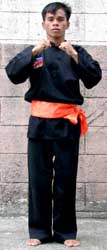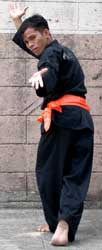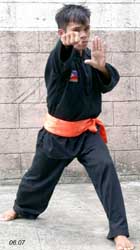Competition Maneuvers of
Keluarga Pencak Silat Nusantara (VI)
Rapid Journal, Vol. 8, No. 2 (Book 28, 2003: 44-45)
© O'ong Maryono
www.kpsnusantara.com
Demonstrated by Abdul Karim Jabad, national coach and trainer KPS Nusantara (Manila, The Philippines)
Following the previous exploration of KPS Nusantara competition maneuvers, here we will present the sixth sequel or jurus pertandingan VI, as performed by Abdul Karim Jabad, trainer of KPS Nusantara at Rizal Memorial Stadium, Manila, and a national coach. Again it should be noticed that there are many similarities with the maneuvers in the previous jurus pertandingan and that the differences mostly lie in the order of movements resulting in different degrees of difficulty.
Defense Tactics
The pesilat stands-by (fig. 1) before moving to standing position XII (sikap dua belas: fig. 2) This standing position signals that the pesilat is ready to fight. From this position the pesilat enters into action by slowly opening the left and right palm, the body turning around with the right leg moving to the fore from the back side in the so-called “stealing step forward” position (sikap tiga) as to invite the opponent to attack (fig. 3). Subsequently, the pesilat completes the body’s turn and then returns to standing position XII (slewah) (fig. 4). From this position the pesilat can decide to attack the opponent.
 |
 |
 |
 |
fig 1 |
fig 2 |
fig 3 |
fig 4 |
Attack Tactics
 |
 |
 |
 |
fig 5 |
fig 6 |
fig 7 |
fig 8 |
rom standing position XII (slewah) the pesilat advances with a left runt palm kick (fig. 5) followed immediately by a rapid landing of the left foot, punching with the left arm (fig. 6) and again punching with the right arm (fig. 7). As soon as the right arm moves with speed forward, a strong front kick is given with the right leg (fig. 8). In closure, the striking pesilat steps back two times, turns into a flying eagle standing position (elang melayang: fig. 9 and 10) and goes back to standby position (sikap siap) in preparation for the following pattern of movements to be discussed in the next issue.
 |
 |
 |
| fig 9 | fig 10 | fig 11 |
back to main page • back to articles from Rapid Journal • next article